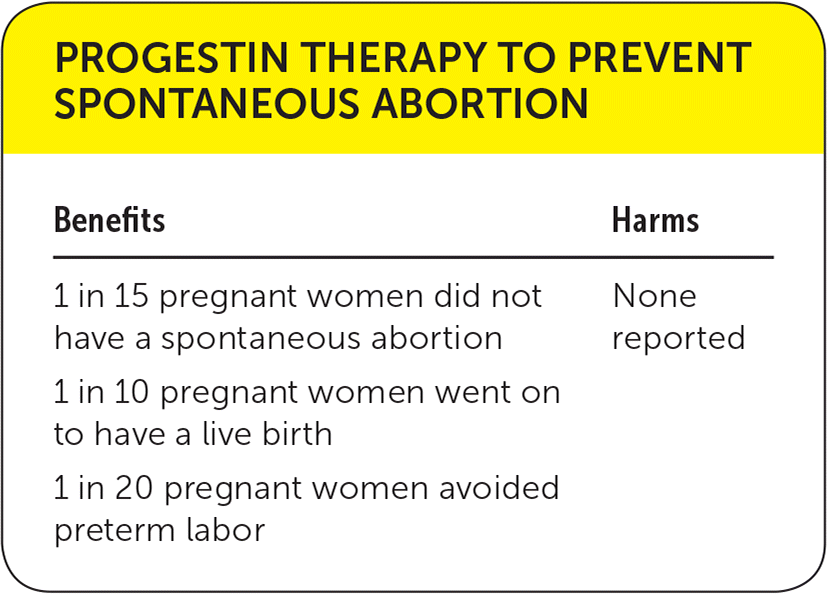
Am Fam Physician. 2019;100(1):online
Author disclosure: No relevant financial affiliations.

Details for This Review
Study Population: Women diagnosed with recurrent spontaneous abortion of unknown origin
Efficacy End Points: Spontaneous abortion, live birth, preterm labor
Harm End Points: None reported
Narrative: Spontaneous abortion, defined as loss of pregnancy before viability, is a common occurrence.1 A small percentage of women will experience three or more losses, a condition referred to as recurrent spontaneous abortion. The physical and emotional toll of recurrent spontaneous abortion can be high. Further, approximately only one-half of women who experience recurrent spontaneous abortion will discover the cause.2
When no cause is diagnosed for the recurrent losses, researchers and physicians postulate that low progesterone levels are the culprit.2 Progesterone plays a vital role in early pregnancy. It is secreted by the corpus luteum to induce changes in the lining of the uterus vital to implantation of the fetus. Theoretically, the administration of progestin or synthetic progesterone in early pregnancy will increase implantation rates and lead to more successful pregnancies. This review evaluates progestin as a therapy for women with recurrent pregnancy loss.3
The primary outcome in this review is spontaneous abortion and the analysis comes out in favor of treatment with progestin: a 26.3% spontaneous abortion rate in the control group and a 19.4% rate in the treatment group (number needed to treat [NNT] = 15; P = .0013). Studies varied in the method of administration of progestin, and no difference was shown between different routes. For the secondary end points that reached statistical significance, progestin therapy came out favorably. Patients saw decreased rates of preterm labor (NNT = 20; P = .012) as well as increased rates of live birth (NNT = 10; P = .042). Stillbirth rates were also decreased (NNT = 16; P < .00001).

| Benefits | Harms |
|---|---|
| 1 in 15 pregnant women did not have a spontaneous abortion | None reported |
| 1 in 10 pregnant women went on to have a live birth | |
| 1 in 20 pregnant women avoided preterm labor |
Caveats: Although the numbers are remarkably positive regarding progestin use, the authors of the Cochrane review were hesitant to give progestin their full support.3 In the case of the primary outcome, evidence was downgraded because of heterogeneity. A second analysis removing four trials for higher risk of bias showed less certainty in the power of progestin. There were also several studies included in the primary analysis that accepted women with two or more spontaneous abortions, less than are typically needed to diagnose recurrent spontaneous abortion. The authors attempted an independent assessment of women with three or more spontaneous abortions, but t he analysis did not reach statistical significance.
Secondary outcomes come with their own caveats. Stillbirth is uncommon, with one study showing dramatically higher rates than commonly observed. If this study is removed from the analysis, there is no difference between the treatment and control arms. Data supporting progestin use to reduce preterm birth were also primarily from one study in which the women received progestin up until 28 weeks' gestation, far longer than other trials. Without this study, the evidence does not support progestin treatment.
It is also difficult to recommend progestin therapy because of a lack of information about the harms of treatment. There was limited evidence on fetal genital anomalies and therefore no recommendation can be made. There were no data regarding other harm-related secondary outcomes: rates of depression, thromboembolic events, subsequent fertility, morning sickness symptoms, or admission to an intensive care unit.
One final note for physicians who treat women with spontaneous abortion. This review evaluates progestin therapy when initiated early in pregnancy, sometimes before the pregnancy is verified. Once a spontaneous abortion has begun, there is no rescue therapy that can be given to save the pregnancy. Low progesterone levels noted during a spontaneous abortion are the result of the spontaneous abortion, not the cause of the loss.
